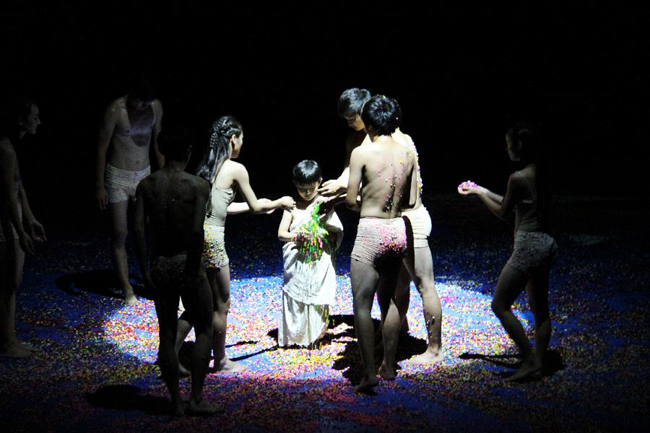 |
|
A stage photo of modern Tibetan dance drama "Shambhala"
|
Unlike traditional televised Tibetan folk galas, the 80-minute dance-drama shunned colorful or grandiose costumes, cheerful actions and ornamental stage. Wanma said the galas that they used were traditional costumes worn by the Tibetan people in their daily lives.
In most cases, the performance in "Shambhala" is like a sketch: dancers wearing cotton clothes in gray or white, most half-naked, emerged from the black background with the help of spotlight. Their faces are sober, sometimes in anguish or in pain.
There is no long and loud music but only the dancers' heaving breaths, the stomping of feet and the strains of folk songs collected from Tibetan villages. Wanma recorded a melody of eagle flute played by a 60-year-old Tibetan artist and added it into the drama. The flute is called eagle flute because it is made from the wing bones of eagles.
Even the old objects that appeared in the dance, such as a horse saddle, a wooden box, and a beam of a house, were all collected by Wanma from the Tibetan pastoral areas during the past few years, most of which are no longer used.
"This drama is very meaningful in terms of folklore, anthropology and dancing arts, explaining the tradition in a real modern way. People from various countries can understand it well as it tells a universal truth that transcends any religion," said Lee In-Sook, council member of South Korea's Dancing Association.
Maybe the only colorful part of the drama is making a compact version of "Mandala." Mandala represents the Universe in Tibetan Buddhism. Tibetan monks often spend days, even months making a Mandala picture with colorful sand and then destroy it in a second as a way of spiritual cultivation and rebirth. It is one way of teaching people not to be seduced by the outside world which is as fragile as the work made of sand.
We Recommend:
